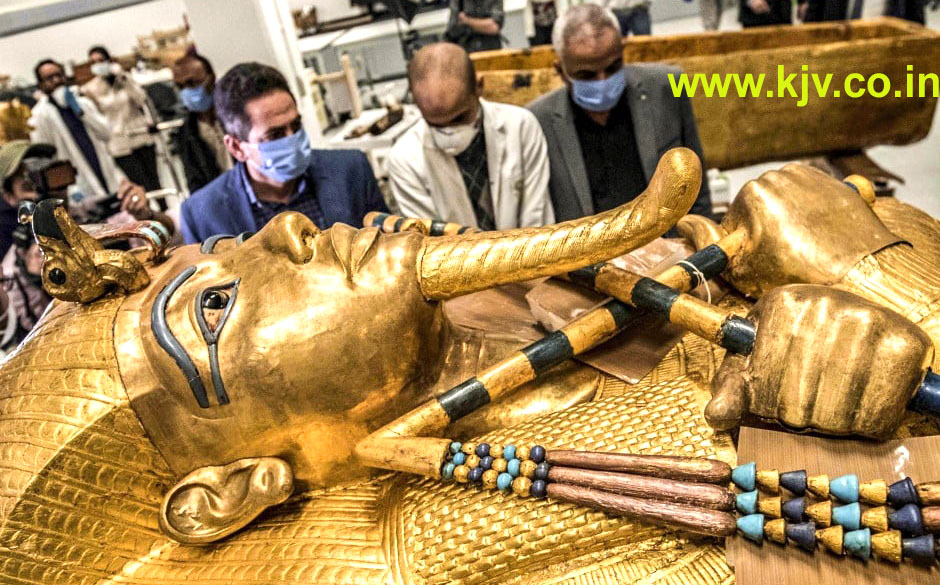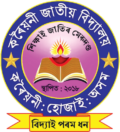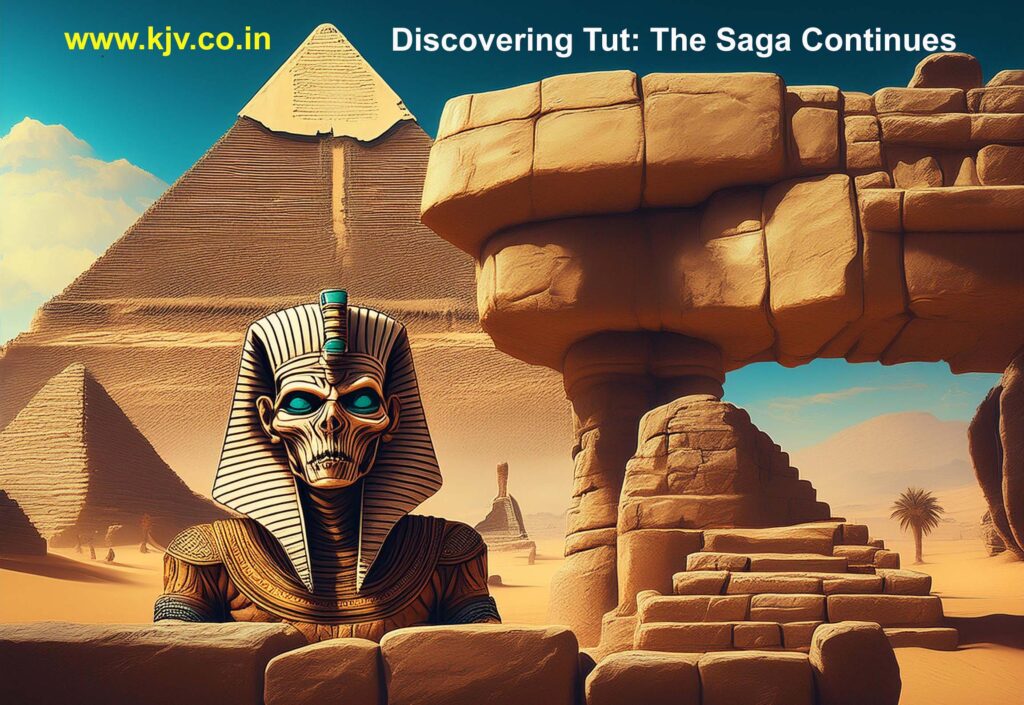Class 11 English Chapter 3 Hornbill Question Answer, Discovering Tut: The Saga Continues, you can find the question and answer sections for each chapter in the list provided. This allows you to easily browse through the different chapters. Class 11 English Hornbill Question Answer, HS 1st year English Notes is prepared by kjv teachers.
Discovering Tut: The Saga Continues
HS 1st Year English Ch 3 Discovering Tut: The Saga Continues Question Answers are given in this post. You’ll gain a solid understanding of the subject using the detailed solutions available here. The Class 11 English Snapshots Solutions are also available in an easy-to-read page format. Use these resources during your study sessions to help you score well in your exams. These notes are checked by K.J.V Teachers.
TEXTUAL QUESTIONS AND ANSWERS
1. Give reasons for the following :
(i) King Tutť’s body has been subjected to repeated scrutiny.
Ans: King Tutankhamun’s mummy is famous because of the treasures found in his tomb. People also wonder how he died and how old he was when he died. Because of this Tut’s body has been subjected to repeated scrutiny.
(ii) Howard Carter’s investigation was resented.
Ans: In 1922, British archaeologist Howard Carter found King Tutankhamun’s tomb. Eighty years later, the mummy was taken out for a CT scan to help solve the mysteries of his life and death. Carter was mainly interested in the gold treasures and didn’t focus much on learning about Tutankhamun’s life or how he died.
(iii) Carter had to chisel away the solidified resins to raise the king’s remains.
Ans: Carter had to chisel away the hard resin to lift King Tutankhamun’s remains. The resin had hardened and stuck Tut to the bottom of his gold coffin, so no regular force could move him.
(iv) Tut’s body was buried along with gilded treasures.
Ans: Ancient Egyptians believed in the afterlife, so they buried great treasures along with the dead body. Tut was adorned with all such riches for his journey after life.
(v) The boy king changed his name from Tutankhaten to Tutankhamun.
Ans. The young king changed his religion, abandoned the Aten, and started to worship the god Amun.This caused him to change his name to Tutankhamun, or “living image of Amun”.
Question 2: (i) What actions led Ray Johnson to call Akhenaten ‘wacky’?
Answer: Akhenaten, whose name means “servant of the Aten” (the sun disc), moved the religious capital from Thebes to a new city called Akhetaten (now Amarna). He destroyed images of Amun, a major god, and shut down his temples. These actions made Ray Johnson describe Akhenaten as ‘wacky’.
(ii) What were the results of the CT scan?
Answer: The CT scan provided useful results, creating 1,700 detailed cross-sectional X-ray images. The images showed a clear outline of Tutankhamun’s head, neck vertebrae, hands, ribcage, and skull. They indicated that there were no serious issues with Tut’s body.
(iii) What technological advances have improved forensic analysis?
Answer: Advances in technology have greatly enhanced forensic analysis. Key tools include X-rays, ultrasound, CT scans, post-mortems, autopsies, and biopsies. These methods help diagnose and provide accurate information about the causes of crime.
(iv) Explain the statement, “King Tut is one of the first mummies to be scanned in death, as in life…
Ans. King Tut has remained the most enigmatic ruler of ancient Egypt. The above line indicates that King Tut’s body was the first to be scanned under a computer tomography machine. Just like King Tut might have led his kingdom when alive, he led the experience of being scanned among the mummies.

TALKING ABOUT THE TEXT
Discuss the following in groups of two pairs, each pair in a group taking opposite points of view.
1. Scientific intervention is necessary to unearth buried mysteries.
Ans. For: It helps determine information about ancient cultures, traditions, and people. The use of advanced scientific tools helps in extracting important facts related to past events. It helps in determining the time and place of the event. It gives us important information about the unsolved mysteries.
Against: The Present is valuable and we must live in the present. Delving into the past is a waste of time and energy. It is the job of the historians and not scientists.
2. Advanced technology gives us conclusive evidence of past events.
Ans: For: I agree that advanced technology provides conclusive evidence of past events. Many historical events lack proper written records and are surrounded by myths and legends. Facts and fiction often blend, making it hard to separate them. Historical accounts can be biased, with facts altered to suit specific agendas. Advanced technology, however, allows us to analyze and understand the past more accurately, providing a clearer and more objective view.
Against: I disagree that advanced technology always provides conclusive evidence of past events. While technology can be useful in certain cases, it doesn’t guarantee complete accuracy. Sometimes, the data obtained can lead to conflicting interpretations and more confusion. Additionally, technology might only offer limited insights, such as dating events, but may not fully explain the causes or consequences of those events.
3. Traditions, rituals and funerary practices must be respected.
Ans. For : Traditions, rituals and funerary practices are born out of the sentiments and feelings of a community. They provide identity to a community. Tradition contributes a sense of comfort and belonging.
Against : A tradition is something you do regularly. It is a tradition in our family to gather for Thanksgiving. A superstition implies some sort of cause and effect. It is a belief, with no evidence, that one act will cause or deter another. Traditions, customs and funerary practices may encourage superstition. They may hamper the development of the society.
4. Knowledge about the past is useful to complete our knowledge of the world we live in.
Ans: For: Knowing about the past is important because it helps us understand who we are today. Our present comes from our past, and our future is built on what happened before. We learn from past experiences and use that knowledge to improve our lives. The stories of people from the past can guide and inspire us, helping us understand the world better.
Against: To make progress, we need to focus on the future rather than the past. The past is over, and we should move on from it. Our world and our needs have changed, so knowing about past traditions and tools might not help us much in today’s fast-paced and complicated world. Understanding our current situation and future possibilities is more important.
Thinking About Language
Read the following piece of information from The Encyclopedia of Language by David Crystal.
“Egyptian is now extinct: its history dates from before the 3rd millennium BC, preserved in many hieroglyphic inscriptions and papyrus manuscripts. Around the 2nd century AD, it developed into a language known as Coptic. Coptic may still have been used as late as the early 19th century and is still used as a religious language by Monophysite Christians in Egypt.”
Question 1:
What do you think are the reasons for the extinction of languages?
Answer:
A language becomes extinct when its use is restricted to certain classes or categories of people. Secondly, the harshness of rules and lack of flexibility in usage also contribute to the extinction of languages.
Question 2:
Do you think it is important to preserve languages?
Answer:
I think it is important to preserve languages. Various languages are the vehicles of thought and medium of interaction between the users of that language and the outside world. A language has intimate connection with the lives, culture and civilization of the people and reflects their thinking.
Question 3:
In what ways do you think we could help prevent the extinction of languages and dialects?
Answer:
Certain steps must be taken to help prevent the extinction of languages and dialects. The most important is to encourage its use. A language thrives as long as it is used by masses. Measures should be taken to propagate the languages and dialects used in certain areas. The help of interpreters may be provided for interaction between native users of language/dialect and non-users. Certain incentives in the form of stipends, scholarships, preferences in jobs etc. may also prove handy in attracting the youth towards languages and dialects which are on the verge of extinction. State patronage can also help in the preservation of languages.
THINKING ABOUT LANGUAGE
1. Read the following piece of information from The Encyclopaedia of Language by David Crystal.
The Egyptian language is now extinct and dates back to before 3000 B.C. It is found in many ancient inscriptions and papyrus manuscripts. By the second century A.D., it evolved into a language called Coptic. Coptic was still used until the early 1800s and is still used as a religious language by some Christian groups in Egypt today.
2. What do you think are the reasons for the extinction of Languages?
Ans. Some of the reasons for the extinction of language are as follows:
(i) Constant changes in the society.
(ii) World globalization through new technologies and telecommunication.
(iii) An example of an extinct language is Latin, because it no longer changes or is used for communication.
3. Do you think it is important to preserve languages?
Ans. Yes, it is important to preserve languages as they are responsible for the development of the culture of the community. It helps in the preservation of one’s heritage and traditions. Language allows us to share our ideas, thoughts, and feelings with others. It has the power to build societies.
Extra Question Answers
Question 1:
Why is 5th January 2005 significant in Tutankhamun’s saga?
Answer:
On this date for the first time Tutankhamun was removed from his tomb and taken to a C.T. scanner brought there to probe the lingering mysteries surrounding this young ruler.
Question 2:
How was the atmosphere when Tut’s body was taken for C.T. scan?
Answer:
The violent wind raised ghost-like shapes of dust. Bulging clouds moved quickly across the desert sky and hid the stars in the grey sky.
Question 3:
How did the visitors to Tut’s grave pay their respects to him?
Answer:
They gazed at the murals on the walls and peered at Tut’s gilded face on his mummy-shaped outer coffin lid. Some visitors read from guide book in whisper. Others stood silently.
Question 4:
What according to A.R. Williams were the thoughts of the visitors who stood silently near Tut’s grave?
Answer:
Perhaps some of them were thinking deeply over Tut’s untimely death in his teens. Others might be trembling with fear and wondering if the Pharaoh’s curse was really true.
Question 5:
What was the Pharaoh’s curse? Who refers to it and in what context?
Answer:
The pharaoh’s curse was that death or misfortune would fall upon those who disturbed him. The silent visitors are the first to refer to it. Later on a guard joked nervously when the million dollar scanner stopped functioning because of sand in a cooler fan.
Question 6:
Who was Carter, and what did he do to the mummy?
Ans: Howard Carter was a British archaeologist who discovered Tutankhamun’s tomb in 1922. To remove the mummy from its coffin, his team had to cut off the mummy’s head and joints to take off the gold decorations.
Question 7:
What problem did Carter face with the mummy, and how did he solve it?
Ans: Carter found that the resins used in the burial had hardened, sticking Tut to the bottom of his gold coffin. Since the sun’s heat couldn’t melt the resins, they had to be chiselled away to free the mummy.
Question 8:
How did Carter justify cutting the mummy free?
Carter argued that cutting the mummy was necessary to prevent thieves from breaking into the tomb and forcibly removing the gold decorations.
Question 9:
What were some of the golden items found on Tut’s body?
Tut’s body was adorned with gold collars, necklaces, bracelets, rings, amulets, a ceremonial apron, sandals, sheaths for fingers and toes, and a solid gold coffin and mask.
Question 10:
Why did royals carry so much gold to their graves?
Royals were very wealthy and believed they could take their riches with them into the afterlife.
Question 11:
What makes the contents of Tut’s tomb special?
The artifacts found in Tut’s tomb, especially the gold ones, are the richest collection ever discovered. They caused a great sensation when found and continue to attract a lot of attention.
Question 12:
What evidence suggests Tut was buried in March or April?
Tut’s shroud had faded garlands of flowers and leaves that only appear at the end of winter, suggesting he was buried in March or April.
Question 13:
How did Carter’s team handle Tut’s body while removing the gold?
They cut off Tut’s head and joints to get the gold off and then put the remains back together in a wooden box with sand and soft material to hide the damage.
Question 14:
What surprising discovery was made about Tut’s mummy in 1968?
In 1968, an X-ray revealed that Tut’s breastbone and front ribs were missing beneath the resin covering his chest.
Question 15:
Why is a CT scan better than an X-ray?
A CT scan creates a 3D image by combining many X-rays taken from different angles, while an X-ray gives only a flat, 2D picture.
Question 16:
What two questions about Tut are still unanswered?
We still don’t know how Tut died or how old he was when he died.
Question 17:
How has archaeology changed in the twentieth century?
Archaeology now focuses more on understanding everyday life and death, and uses advanced tools and medical technology.
Question 18:
How was Tut’s body transported to the CT scanner?
Tut’s body was carried from the tomb in a wooden box. Workers climbed a ramp and stairs and then used a hydraulic lift to move it into the trailer with the CT scanner.
Question 19:
What problem did the CT scanner have, and how was it fixed?
The scanner stopped working because sand got into a cooler fan. It was fixed with substitute plastic fans brought from a nearby office.
Question 20:
Why did Zahi Hawass smile and feel relieved?
Zahi Hawass was relieved and smiled because the CT scan showed that Tut’s head, neck, and ribcage were in good condition, and the work wasn’t affected by the so-called curse of the Pharaoh.
Question 21:
What was the atmosphere like after the CT scan?
After the CT scan, it was nearly midnight, the wind had stopped, the dust storm had cleared, and the winter air was cold and still. Orion, the symbol of the god of the afterlife, was visible above the tomb’s entrance.


